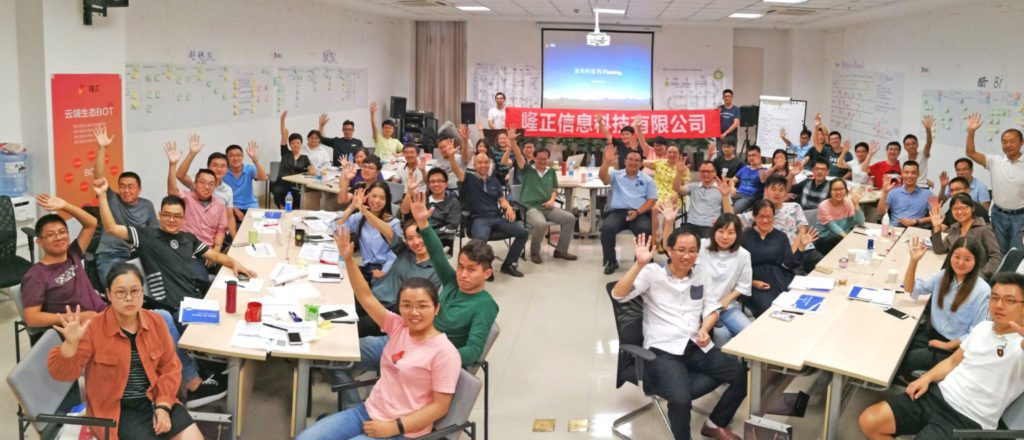
“We collaborate more than ever with our customers by involving them in planning as much as we can. And we deliver frequent demos—even beyond customers’ expectations. Our customers have found communication to be more effective since the SAFe implementation.”
—Sam Wu, Agile Head Coach and Training Director, Cerno
Challenge:
Deliver custom solutions faster and with higher quality for clients.
Industry:
Information Technology, Software
Results:
- Delivery cycle time dropped by 58%
- The rate of release failure went down from 0.6 times on average per release to 0
- The interface automation level increased from zero to 70 percent
- Reported defects decreased from 13 times per release to five
Best Practices:
- Power through setbacks – Find solutions and don’t let them stop your momentum.
- Assess regularly – Inspect & Adapt and DevOps health checks keep teams aware of progress and on track toward goals.
- Choose a compatible partner – A partner with a business view, not just R&D, moved Cerno ahead with training and coaching.
Introduction
As a custom software factory, Cerno is poised for rapid growth as part of China’s expansive technology market. The company delivers technologies such as artificial intelligence, blockchain, cloud computing, open source software, and IoT solutions for a diverse range of clients, from logistics to government.

To compete effectively, Cerno set out to elevate the speed of delivery, reduce defects, and improve the quality of its solutions in the long term, with the ultimate objective of being more client-focused.
“We needed a next-generation software development method to meet customer needs and reach our goals,” explained Sam Wu, Agile Head Coach and Training Director, Cerno.
Cerno’s founders brought experience in developing software for the financial industry. They found the ‘weak matrix’ structure worked in HR outsourcing, but not so well in product delivery. (A weak matrix is an organizational structure in which the balance of power tilts decisively in the direction of line or functional management.)
And while the traditionally waterfall company had experimented with Lean-Agile development in the past, they lacked the training or business support to build momentum.
SAFe®: The Path from Strategy to Delivery
While attending Leading SAFe® training, a Cerno executive saw a promising path to Agile, leading Cerno to adopt the Scaled Agile Framework® (SAFe). “It was clear that we needed SAFe to make Cerno a total Agile enterprise, to expand Agile not only to product lines but also to the business and functional departments such as HR and finance,” explained Liu Yilei, VP, Cerno. “We saw SAFe as the model that would take us from strategy to delivery.”
“SAFe provided a comprehensive toolkit and an easy way to move forward,” added Wu, who was hired at that time to lead the effort as the internal change agent. At the same time, the company brought in SAFe Gold partner Aura International for coaching and training.
Per the SAFe Implementation Roadmap, James Li, Principal Consultant from Aura, led the SAFe Executive Workshop. Jack Xu, Senior Consultant from Aura, delivered SAFe® for Teams training and helped prepare for the first Program Increment (PI) planning event. They organized teams, reconfigured the office to better support those teams, and reorganized the product plan with user-story mapping.
For the first Agile Release Train launch, they began with four Agile teams—the entire R&D team plus Infrastructure and Operations—on an existing initiative to digitalize a logistics solution for a client.
From that first PI, team leaders embraced the Lean-Agile mindset. They identified priorities based on business value and began allowing people to self-organize. Instead of waiting to be assigned work, developers identified the work based on business objectives, committed to the work in PI Planning, and moved forward with it.
More Stories in Less Time—Despite Setbacks
Though Cerno set out to follow SAFe by the book, they ran into roadblocks that forced mid-course adjustments. In middle of the first PI, the Systems Architect left, leading Cerno to assemble a team to assume his responsibilities.
Additionally, the customer cut some funding because of market forces. And when managers wanted to move some teams to another client project, it nearly stopped the train. Given technical and capacity challenges, Cerno chose to postpone 15 percent of the high-risk PI objectives and scale back the size of the train.
Developers also found it challenging to transition from private to public code, a decision made to reduce bottlenecks in bug fixes and hidden technical debt. As the project team transitioned away from three-week waterfall development, the coaching team helped set code standards. In time, they found that developers took more pride in their code because of its public nature.
Even with the early challenges, the Inspect and Adapt session after the first PI showed the teams had met PI objectives and reduced defects. The ART could produce 45 stories per two-week iteration, on average, by the end of the first PI, compared to 30 stories per three-week iteration in waterfall.
Routine DevOps Health Checks
When Cerno first introduced DevOps practices, the company lacked a SAFe DevOps Practitioner. Still, they made progress on a delivery pipeline and staging environment, supported a grayscale release of a product, and shortened the time to release future versions.
Additionally, they formed a new system integration testing (SIT) plan that shrunk testing time by 25 percent initially, and then by half, freeing the development team to put more effort into new features.
To expedite progress, they began conducting DevOps health checks. Early on, those checks uncovered opportunities to improve delivery. To stay on track, they now perform this exercise every PI. With the habit of regular checks, Cerno has made strides with automated testing and continuous integration/continuous deployment.
To support their efforts, they also established Communities of Practice and hold monthly technical workshops for developers.

Delivery Cycle Time Down 58 Percent
Today, Cerno runs two ARTs with 80 people. These high-confidence teams agree on, and begin working on, requirements faster. They communicate and collaborate more tightly than before they introduced SAFe and are continuously improving.
When the ART completed work with one client, they simply switched the train to support another logistics client with a similar solution—effectively a plug-and-play release train. The company then added a second ART to deliver value to another client. Each train continues to serve a single client.
To date, Cerno has made remarkable progress:
- Delivery cycle time dropped from 3½ weeks to two weeks, or 58 percent
- The average offline time for a new production environment release decreased from 3½ hours to half an hour
- The rate of release failure went down from 0.6 times on average per release to 0
- The interface automation level increased from zero to 70 percent
- Reported defects decreased from 13 times per release to five
Most importantly, Cerno realized its goal of becoming a more customer-centric organization.
“We collaborate more than ever with our customers by involving them in planning as much as we can. And we deliver frequent demos—even beyond customers’ expectations,” Wu said. “Our customers have found communication to be more effective since the SAFe implementation.”
“This is the first SAFe transformation case I have coached in a local company in China,” Li said. “Although there’s still more to improve, it is really a great and wonderful start! It is a significant milestone for SAFe in China.”
Looking ahead, Cerno is building toward agility beyond solution delivery, into administrative management and marketing—to become a total Agile enterprise.

Share:
Back to: All Case Studies
Suggested Case Study: Amdocs